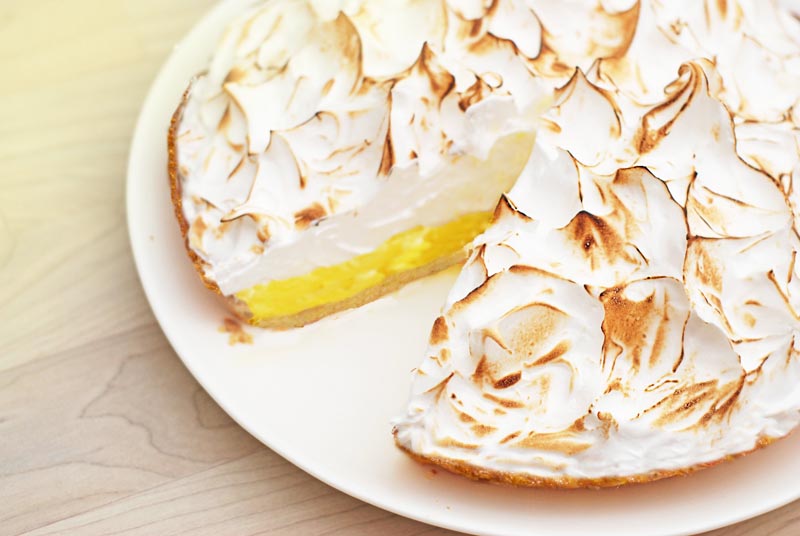When baking gluten free meringue can lighten batters and make wonderful toppings and fillings. You learned all about eggs in Lesson 5: Eggs & Gluten Free Baking. In this lesson, you’ll add sugar and perhaps a stabilizer to those eggs to make varieties of meringue.
What Makes the Varieties of Meringue Different?
What differentiates the varieties of meringue is the amount of sugar to egg ratio. In addition, heat is applied to two varieties of meringue in two different ways.
The Role of Sugar in Meringue
Sugar obviously sweetens meringue but it also stabilizes the whipped egg whites to prevent collapsing.
The Role of Stabilizers in Meringue
Adding an acidic component to meringue such as cream of tartar, lemon juice, or vinegar helps stabilize meringue just as the sugar does. Sometimes starch is added to provide a little more structure.
Why Should I Never Add Fat to Meringue?
You may have heard that fat is an enemy to whipped egg whites. When you read about it, you may assume that a tiny bit of grease on the surface of a mixing bowl or electric beaters will cause the whipping of egg whites to fail. However, it is not detrimental if your mixing bowl has a tiny bit of grease on it. Your meringue may, however, take a little longer to whip. Even if you get a tiny bit of egg yolk in your meringue bowl, it is not the end of the world. Just remove as much as you can from the ingredients. However, if you add half of a yolk, you may suffer serious repercussions. Your egg white will probably not whip. In this case, just start over.
Tips for Successful Meringue
- Always use room temperature eggs. However, room temperature eggs are difficult to separate. Therefore, separate them while they are cold and then allow the whites to reach room temperature.
- Plastic bowls usually contain trace amounts of grease. Therefore, use stainless steel, copper, glass, or porcelain.
- Add in the sugar slowly to help it dissolve.
French or Common Meringue – Baked Hard or Added to Cakes to Leaven/Lighten – Least Stable
The least stable of all meringues is French Meringue. Using sugar, egg whites, and a stabilizer, meringue is made for baking use. Usually, this type of meringue is baked in the oven. Therefore, there is no need to heat the egg whites prior to whipping. However, sometimes, a different type of meringue tops pies, where it is not necessary to bake the meringue.
Use French meringue to make crisp cookies, airy Pavlovas, or fold into batter to leaven sponge cakes, angel food cake, and souffles. This is an excellent way to lighten and leaven heavy gluten free cakes, cupcakes, and muffins. You can even add French meringue to gluten free pancake batter.
Because French meringue is not very stable, you must use it as soon as it is whipped.
Swiss Meringue: Heated and Used Soft
In the case of meringue that will not be baked, you need to heat the egg whites to prevent salmonella. Heating eggs to 140⁰F pasteurize (lightly cooks) them.
In Swiss meringue, you beat together the egg whites and a slightly higher amount of sugar over simmering hot water until they reach 140⁰F. Then, transfer the mixture to a cool bowl and whip using your mixer. This method varies slightly depending upon its use.
Use Swiss meringue in buttercream frosting,to decorate cakes and other desserts, and even as a filling for cakes and pastries. Also fold this meringue into custards, pudding, and mousses to lighten them.
Italian Meringue: Heated and Used Soft or Baked Hard – Most Stable
Instead of heating the eggs over hot water, you use sugar syrup to heat the whipped egg whites. This sugar syrup uses a higher ratio of sugar than it takes to make Simple Syrup. Three-quarters of the sugar is used to make the syrup and one-quarter is used to beat the egg whites. To add stability/structure, a stabilizer is added such as cream of tartar. This method creates a silky meringue and one that is more stable than any other.
Italian meringue can be used to make silky and stable buttercream frosting, shells to make Pavlovas, and smaller sized shells to make cookies. Italian meringue is also perfect for enveloping the layers in Baked Alaska. You can also use this silky mixture to top pies or cakes that you don’t plan on baking. You can torch the meringue if you wish to create a baked appearance. However, a torch shows off the piping design where baking doesn’t so much. You can also use Italian meringue in place of frosting. It tastes like Marshmallow Fluff.
To make just the Italian Meringue, follow the instructions in the Italian Buttercream Frosting, from the beginning through step number 5 of T”o Make the Meringue”.
Tips to Remember:
- Add eggs to your mixing bowl prior to adding any other ingredient. This way, just in case you add some egg yolk to the whites, you can start over without having wasted other ingredients.
- As you learned in the egg lesson, the more you beat meringue, the drier and lighter it becomes.
ASSIGNMENT:
Make at least one of the below recipes. If possible, eventually make one from each category. If you can’t master every single one, stick with the one you can make best. That will bring you the most pleasure and best desserts.
Meanwhile, text, phone, or email me with any questions.
If you need to refer back to the Egg Lesson for anything, you’ll always find earlier lessons on the Syllabus page.
French Meringue:
Floating Island (Contains Poached Meringue and Custard)
Meringue Ghosts – Perfect for topping frosted cakes
French Macarons (Cookies)
Swiss Meringue:
Italian Meringue:
Pumpkin or Sweet Potato Meringue Pie
Italian Meringue / Italian Buttercream Frosting
Egg-Free Meringue (for those with egg allergies):


